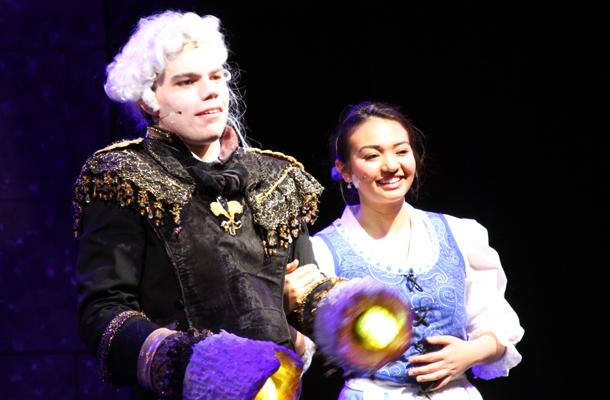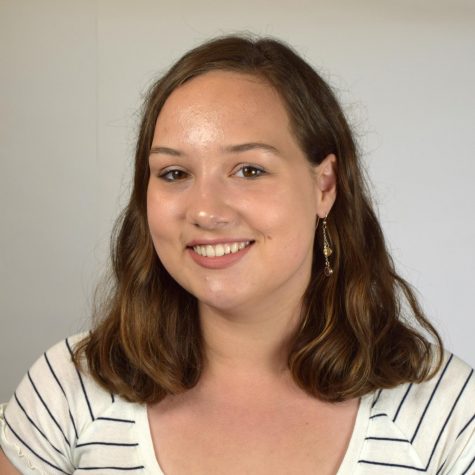Spring Musical Wraps Career for Senior Vocalists
March 30, 2017
Choir, band, orchestra, and tech crew combined for the annual spring musical, Beauty and the Beast during the weekends of March 18 and 26, with “Rose” and “Mirror” casts trading performance dates.
The musical’s opening night fell on the same day as the highly publicized live-action Disney film premiere. Choir director Mark Robert said, “We picked the show before [the movie] was publicly announced, or promoted. It was sort of serendipitous, or coincidental.”
Choosing a musical is an extensive process, according to Roberts. “Typically what we do any given year is we think about shows that we have done, and we try to do shows that we’ve done that contrast the past. So it’s like a traditional musical theatre show versus something more contemporary, versus something heavy and dramatic, versus something comedic – family-friendly or adult-oriented. We think about mostly thematic things like that.”
Other considerations include the complexity of costumes and set pieces. It takes a program well-equipped with parent volunteers to pull off an elaborate production like Beauty and the Beast.
According to Roberts, the students and parents involved in the production have a lot to be proud of.
“I think that the show as a whole was really cohesive, really well-done. I thought the production value was very high. Everything from the lighting, the costumes, the mics, to the artistry of the sets and the performances,” said Roberts. “I mean, it’s a high school production. When you consider that, that nobody’s a professional and that everybody is learning while they’re doing it, it’s a tremendous success. It’s a smashing success. I’ve been to other high school shows, and it’s apples and oranges in a lot of ways.”
The setting for this year’s musical alternated between a quirky provincial town and an enchanted, spell-bound castle. “It’s a world where people are much more naive than they are here. That naivety and that lack of leadership I think, the tendency of people in that world to follow stronger personalities- whether that’s a good thing or a bad thing -it’s part of the reason that the show gets so confusing and chaotic,” said Sophomore Claire Sebree who played the part of “Silly Girl”.
Thematic elements of this show are classic Disney. “The ongoing struggle between good and bad is always very apparent. Even though sometimes the lines are blurred. At the end, where the Beast pulls Gaston up after he almost falls, that’s a moment of showing mercy, and that’s not a simple thing to understand. That’s a complex thing, and a complex character shift that we see,” Sebree explained.
Within the madness of the villagers, Belle serves as a more inherently grounded character, especially in comparison to suitor and antagonist Gaston and his cronies. Senior Jocelyn Purcell, who played Belle in the production’s “Mirror” cast, said, “The best thing about Belle is that she’s not like any of the other princesses because she actually has motive and objective in her life, rather than waiting for a prince and waiting for something to happen in her life. She decides to take the initiative in changing what’s happening because she dreams about better things from what she reads in her books.”
“Belle doesn’t wish any misfortune on anyone,” continued Purcell. “With Gaston, her and her actions with Gaston, she’s totally pushed back by him in every kind of way that you could think of, but she kills him with kindness. And she gets her way by being unlike any other person in her provincial town. Everyone thinks she’s weird because she’s different, and she likes things that they don’t know about. But she doesn’t really care, she just sticks to what she dreams of, and eventually pursues it. Which is a really strong message for little girls watching it.”
A stark contrast to Belle’s hometown peers are the characters that populate the enchanted castle. The play relies upon an ensemble-heavy scene for it’s most impressive number, “Be Our Guest”.
Junior Alex Kolm played Cogsworth, a principal character in the Beast’s enchanted castle.
“The thing with having a principal role is that a principal, as opposed to an ensemble character, has a defined personality, has defining characteristics, a way they carry themselves, a way they talk to people, a way they interpret things,” said Kolm. “So when you get a principal role, you have to take that onto yourself, you have to become that personality, and that’s what I really love about acting. It’s a lot of fun to become a lot of different personalities. Whereas, in the ensemble, I think I actually might like ensemble roles a little bit more, because you get to choose the personality.”
While Kolm played a “snooty, uptight, and by-the-book” character, other enchanted objects in the castle were able to form their own. unique personas.
The annual spring musical often serves as a last farewell for those who have spent several years in the program. “I think this year was really sad, just because a lot of really key figures in the choir community are leaving,” said Sebree. “And also orchestra, and tech, and stage management are leaving as well. I think the show was a good farewell to them. It served its purpose and pulled itself together at the end. It was a good send-off.”
“In that way, it was rewarding to watch their hard work and their time there culminate in such a successful spectacle and feel that I played at least a small role in helping them achieve that, and giving them something that they can be proud of, and have a memory,” said Roberts of his soon-to-graduate seniors.
“These kinds of experiences with so much happiness don’t really bring me to tears. It’s kind of like being filled with joy,” said Purcell.
“I guess the biggest thing was saying goodbye to it, it was the most emotionally taxing thing to think about, and seeing it all fade away as we striked the set, and putting away my stuff that I had in my box the last three weeks was really difficult, because it’s my favorite part of the year. Not coming back to it is going to be bittersweet. I’m ready to move on and grow up, but it’s a good thing to look back on more than it will be to let go of,” Purcell added.
According to Kolm, the quality of the product each year is a reflection of the investment students make, the risks they are willing to take. “The choir program is all about learning how to make mistakes and being okay with it. Because, in choir, if you sing a wrong note, wrong rhythm, your voice cracks or whatever, you’ve gotta be okay with it, because everybody in that choir community is accepting and kind,” said Kolm. “And learning how to mistakes, I think, has really made me and the rest of people in choir better performers, better actors.”

